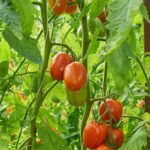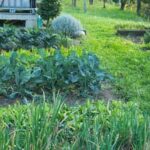ACQ, or alkaline copper quaternary, is a commonly used wood preservative for outdoor construction projects, including vegetable garden structures. The safety of using ACQ-treated wood in vegetable gardens has been a topic of discussion among gardening enthusiasts and researchers alike. In this article, we will delve into the question “Is ACQ Safe for Vegetable Gardens” and explore the key factors and considerations surrounding this issue.
ACQ treatment is a process that involves injecting copper into wood fibers to protect it from decay and insect damage. This preservation method has become popular as an alternative to pressure-treated lumber containing harmful chemicals such as chromated copper arsenate (CCA). While ACQ is effective in prolonging the lifespan of wood, concerns have been raised about its potential impact on soil, plants, and human health in the context of vegetable gardening.
In this article, we will provide an overview of what ACQ is and how it works in wood preservation. We will also examine the specific concerns related to using ACQ treated wood in vegetable gardens and discuss relevant research and studies on its safety. Additionally, we will explore best practices for utilizing ACQ treated wood in vegetable gardens and consider alternative options for constructing garden structures.
What Is ACQ and How Does It Work in Wood Preservation
ACQ, or alkaline copper quaternary, is a type of wood preservative that is commonly used to protect wood from decay and insect damage. It is a water-based preservative made up of copper, a fungicide, and a quaternary ammonium compound, also known as an “quat”. When applied to wood, ACQ penetrates deeply into the material, providing long-lasting protection against rot and pests.
The process of ACQ treatment involves placing the wood in a pressure vessel and subjecting it to high pressure so that the preservative can be forced into the wood fibers. The chemicals in ACQ bond with the wood fibers to create a barrier that repels decay-causing organisms and insects. This makes ACQ an effective choice for outdoor structures such as decks, fences, and raised garden beds.
One of the concerns related to ACQ-treated wood is whether it is safe for use in vegetable gardens. Since vegetables are grown for consumption, there is understandable concern about any potential health risks associated with using treated wood in close proximity to edible plants.
Many people wonder if chemicals from the treated wood can leach into the soil and be taken up by the plants. Some studies have been conducted to address these concerns and determine the safety of using ACQ-treated wood in vegetable gardens.
Understanding the Concerns About ACQ and Vegetable Gardens
ACQ, or alkaline copper quaternary, is a wood preservative that has been widely used in outdoor structures such as decks, fences, and playground equipment. However, there are concerns about the safety of using ACQ treated wood in vegetable gardens. This section will delve into the specific concerns and considerations regarding the use of ACQ in vegetable gardens.
Potential Risks of ACQ in Vegetable Gardens
One of the main concerns about using ACQ treated wood in vegetable gardens is the potential leaching of copper and other chemicals into the soil. Copper, which is a key component of ACQ, can be toxic to plants if present in high concentrations. Additionally, there is apprehension about these chemicals being absorbed by the vegetables grown in raised beds or containers made from ACQ treated wood.
Regulatory Guidelines and Recommendations
In response to these concerns, regulatory bodies such as the Environmental Protection Agency (EPA) and the U.S. Food and Drug Administration (FDA) have established guidelines for the safe use of treated wood in contact with food crops. It is essential for gardeners to be aware of these guidelines and follow them carefully when using ACQ treated wood in their vegetable gardens.
Balancing Safety and Practicality
While there are valid concerns about the potential risks of using ACQ treated wood in vegetable gardens, it is important to consider practicality as well. Many gardeners opt for raised beds or other structures made from treated wood due to its durability and longevity.
When making decisions about garden materials, it is crucial to weigh both safety considerations and practical needs. Ensuring that proper precautions are taken can help mitigate any potential risks associated with ACQ treated wood while still reaping its benefits for vegetable gardening purposes.
By addressing these concerns and considering regulatory guidelines, gardeners can make informed decisions about whether or not to use ACQ treated wood in their vegetable gardens.
Research and Studies on the Safety of ACQ in Vegetable Gardens
ACQ (alkaline copper quaternary) is a wood preservative that contains copper, which is well-known for its bactericidal and fungicidal properties. This makes ACQ a popular choice for preserving wood used in vegetable gardens, as it helps protect garden structures from decay without posing a danger to the plants or the soil. However, concerns have been raised about the safety of using ACQ treated wood in vegetable gardens, leading to various research and studies to determine its impact.
Research on the safety of ACQ in vegetable gardens has shown that while copper can leach from the treated wood over time, the amount that reaches the soil is minimal and does not pose a significant risk to plant health or human health. Studies have also demonstrated that the levels of copper leaching from ACQ treated wood are within acceptable limits set by regulatory agencies such as the Environmental Protection Agency (EPA).
Furthermore, research has indicated that ACQ treated wood does not negatively impact soil microbial communities or affect nutrient uptake by plants. In fact, studies have shown that there is no evidence of adverse effects on vegetable garden soil or plant growth when using ACQ treated wood for garden structures such as raised beds or trellises.
Given the results of these research and studies, it is clear that ACQ is safe for use in vegetable gardens. It provides an effective means of preserving wood for garden structures without posing significant risks to plant health or soil quality. However, it is important for gardeners to follow best practices when using ACQ treated wood in vegetable gardens to minimize any potential risks.
Best Practices for Using ACQ Treated Wood in Vegetable Gardens
When it comes to using ACQ treated wood in vegetable gardens, there are some best practices that can help minimize any potential risks. First and foremost, it is important to use a plastic barrier between the soil and the ACQ treated wood to prevent direct contact. This can be as simple as laying a thick plastic sheet or tarp in the bed before adding the soil.
Another best practice is to avoid using ACQ treated wood for any structures that will come into direct contact with edible parts of the vegetables, such as raised beds or trellises for vining plants. Instead, consider using untreated wood, bricks, or stones for these purposes. Additionally, it is recommended to wear gloves when handling ACQ treated wood and wash hands thoroughly after coming into contact with it.
In addition to these best practices, it is crucial to regularly monitor the condition of ACQ treated wood in vegetable gardens. Over time, the chemical may leach out of the wood and into the surrounding soil.
If any signs of deterioration are noticed, such as peeling or cracking of the outer layer, it is advisable to replace the affected pieces with new, untreated wood. By following these best practices, gardeners can use ACQ treated wood safely in their vegetable gardens while minimizing potential risks.
| Best Practices | Benefits |
|---|---|
| Use plastic barrier between soil and wood | Prevents direct contact |
| Avoid using ACQ for structures in direct contact with edible parts of vegetables | Reduces exposure risk |
| Regularly monitor condition of ACQ treated wood | Identifies potential hazards early |
Alternative Options for Vegetable Garden Structures
When considering the use of ACQ treated wood in vegetable gardens, it’s important to explore alternative options for building garden structures. Here are some alternatives to consider:
1. Cedar or Redwood: These naturally rot-resistant woods are great options for building raised beds, trellises, and other garden structures. While they may be more expensive upfront, they can last for many years without the need for chemical treatment.
2. Composite Materials: There are many composite materials on the market that mimic the look of wood but are made from a combination of wood fibers and recycled plastic. These materials are often resistant to rot and insects, making them a low-maintenance option for vegetable garden structures.
3. Concrete Blocks or Pavers: Building raised beds with concrete blocks or pavers is another durable and long-lasting option. They can be stacked to create various heights and shapes, providing a versatile solution for vegetable garden layout.
4. Metal Garden Beds: Prefabricated metal garden beds made from materials such as galvanized steel or aluminum offer a sleek and modern look while also being resistant to decay and pests.
When choosing an alternative material for your vegetable garden structures, it’s important to consider factors such as cost, durability, aesthetics, and maintenance requirements. Each option has its own set of pros and cons, so it’s best to weigh these carefully before making a decision on what is best suited for your specific needs.
Remember that whether you choose ACQ treated wood or an alternative material, proper construction techniques and regular maintenance are key factors in ensuring the longevity of your vegetable garden structures.
Tips for Minimizing Potential Risks of ACQ in Vegetable Gardens
Use a Barrier
One way to minimize the potential risks of using ACQ treated wood in your vegetable garden is to use a barrier between the wood and the soil. This can be accomplished by lining the inside of the wood structures with plastic sheeting or landscape fabric. This will help prevent direct contact between the treated wood and the soil where your vegetables are growing.
Choose Your Wood Wisely
When using ACQ treated wood in vegetable gardens, it’s important to select the right type of wood. Opt for woods that have been treated with lower levels of ACQ, such as those labeled as “ground contact” or “above ground.” These types of treated woods are designed to leach fewer chemicals into the surrounding soil, reducing potential risks for your vegetables.
Monitor Your Garden Regularly
To ensure that your vegetables remain safe while using ACQ treated wood in your garden, it’s essential to monitor your plants regularly. Keep an eye out for any signs of distress or unusual growth patterns, and address any issues promptly. Additionally, consider conducting regular soil tests to check for any accumulation of chemicals from the treated wood.
By implementing these tips, you can minimize potential risks associated with using ACQ treated wood in your vegetable garden and help ensure that your plants remain healthy and safe for consumption. Always remember to prioritize safety when making decisions for your garden, and consider alternative options if you have concerns about using ACQ treated wood near edible plants.
Conclusion
In conclusion, when considering using ACQ treated wood in your vegetable garden, it is important to weigh the potential risks and benefits. While ACQ has been found to be a safe option for vegetable gardens according to research and studies, it is crucial to follow best practices and take precautions to minimize any potential risks. It is also essential to consider alternative options for vegetable garden structures to reduce exposure to ACQ-treated wood.
Ultimately, making an informed decision about whether ACQ is safe for your vegetable garden involves considering all available information, consulting with experts, and weighing the potential risks against the benefits. By staying informed about the safety of ACQ in vegetable gardens and following best practices for its use, you can make a decision that will be best for your specific gardening needs while ensuring the safety of your plants and produce.
Frequently Asked Questions
Is ACQ-treated Pine Safe for Vegetable Gardens?
ACQ-treated pine is generally considered safe for vegetable gardens. The chemicals used in this treatment pose minimal risk to plants and humans. However, it’s still important to use a barrier, like plastic, between the wood and soil.
Is It OK to Use Pressure Treated Wood in a Vegetable Garden?
It is generally not recommended to use pressure treated wood in a vegetable garden, especially for raised beds or containers where the soil can come into direct contact with the wood. The chemicals used in pressure treatment can potentially leach into the soil and be absorbed by plants.
What Wood Preservative Is Safe for Vegetable Garden?
When looking for a safe wood preservative for a vegetable garden, consider using non-toxic options like natural oils (e.g. linseed oil), beeswax, or untreated cedar or redwood. These alternatives provide protection against decay while minimizing any potential harm to your vegetables and the environment.

If you’re looking to get into vegetable gardening, or are just looking for some tips on how to make your current garden better, then you’ve come to the right place! My name is Ethel and I have been gardening for years. In this blog, I’m going to share with you some of my best tips on how to create a successful vegetable garden.





